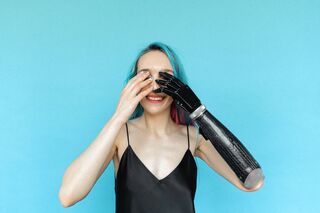Consumer Behavior
Disability in Ads: Celebration or Commodification?
Disability representation is about more than lip service in advertising.
Posted February 17, 2021

by Sydney Tran
Consumers are asking brands to include more diverse and inclusive representations that reflect society. Companies that do not make changes to their representation in ads risk losing customer support.
While this call for inclusion is important, there are a few issues: 1) much of the attention has focused on racial, ethnic, and LGBTQ+ representation and not disability representation, and 2) companies that address these calls for action must do so in a way that is genuine so that their actions are not perceived simply as a marketing tactic. For example, Nike released its Go FlyEase sneaker this week, which was designed in collaboration with disabled people, but failed to focus on the disability community in their ads.
Despite being the largest minority group in the United States, people with disabilities are underrepresented in advertisements. This intentional exclusion is known as ableism. Ableism refers to “stereotyping, prejudice, discrimination, and social oppression toward people with disabilities” (Bogart & Dunn, 2019, p. 651). People with disabilities have historically been banned from public spaces because of their stigmatized attributes. The passing of the Americans with Disabilities Act (ADA) prohibited discrimination against people with disabilities, essentially making it illegal to exclude people with disabilities from physical public spaces. But it still left room for more subtle forms of exclusion—including lack of representation in ads.
A study in 2012 found that out of 1,671 prime-time commercials, only 1.7 percent portrayed people with a disability. Since then, popular brands like Nike, ASOS, Tommy Hilfiger, Microsoft, American Eagle, Target, and Home Depot have responded to consumers with more inclusive campaigns and have increased their disability representation in ads.
Disability Representation: Successes
In 2014, American Eagle’s Aerie line launched its “Aerie Real” campaign to discontinue its use of photo-editing and display more realistic standards of beauty. Aerie has been consistently vocal in the past seven years about its commitment and including “real” people in ads. The brand’s team continues to include a diverse range of models varying in body size, (dis)ability, race, ethnicity, sexual orientation, and career.
Target’s disability representation in digital ads goes as far back as 2012. Then, in 2017, the company launched an adaptive clothing line for kids with disabilities and in 2018, an adaptive clothing line for adults with disabilities.
Aerie’s and Target’s efforts have not gone unnoticed. Consumers have taken their thoughts to social media, praising the brands for their inclusion efforts and sharing what the representation means to them. Aerie increased its sales by 20 percent during the first year of the “Aerie Real” launch and has maintained double-digit sales growth annually for the past five years.
Disability Representation: Failures
However, not every company’s diversity and inclusion initiative has been met with positivity. Brands like Mattel, Nike, and Vogue have been criticized by many for their approaches. In 1997, Mattel, one of the largest toy manufacturing companies in the US, launched a Barbie doll with a disability, Becky, who used a wheelchair. While the first two weeks of Mattel’s launch was a success in terms of sales and praise, the launch was quickly met with criticism as consumers began realizing that Becky’s wheelchair was incompatible with Barbie’s Dreamhouse. In response to this criticism, Mattel discontinued Becky dolls until 2019 when they decided to feature dolls with disabilities again.
Nike’s efforts have garnered mixed reactions, too. Since 2012, Matthew Walzer, a then-teenager with cerebral palsy, has worked collaboratively with Nike in redesigning some of their sneakers to be more accessible. In the past decade, the Nike “FlyEase” adaptive shoe line has released adaptations of the LeBron Zoom Soldier, Air Zoom UNVRS, Air Max 90, Metcon, and more.
Just over a week ago, Nike released a video to promote the newest edition to the FlyEase line, a distinct new hands-free sneaker—not an adaptation of a previous sneaker—that was intentionally designed to be accessible. The Nike Go FlyEase shoe is officially on Nike’s website as of February 15 and has already received some praise from Paralympic fencer Bebe Vio and other members of the disability community.
But it has also received criticisms. Some people are asking why Nike’s ad promotes the accessibility of the design but hardly mentions the disability community or the man who initially called for more accessible footwear. And exclusion from the promotional video is not the only concern. The Nike Go FlyEase is set to sell for $120 USD. With disabled people being twice as likely as non-disabled people to be living in poverty, some are questioning the affordability of the sneakers. Rather than centering on the disability community, Nike is being accused by many of excluding them—potentially earning significant profits on the accessibility marketing tactic while erasing those they profit off.
Inclusion or Objectification?
A brand’s diversity and disability representation in advertising is important to many consumers. Brands may value diversity and disability representation for one of two reasons: 1) brands authentically value their customers and the diverse backgrounds they come from, or 2) brands value revenue.
The latter reason for diversity and inclusion efforts is referred to as objectification. American philosopher Martha Nussbaum defined objectification as the act of treating someone as though they are an object to be used by another person (Nussbaum, 1995). The objectified person is merely seen as an instrument. Another notion of objectification is that the perpetrator treats the objectified person as though they do not have feelings. These two notions may explain the difference between authentic inclusion initiatives and those that are disingenuous and the difference in reactions towards different campaigns, such as that of Aerie’s and that of Barbie’s.
Authenticity maintains customer support, but so does accessibility and affordability. So, it should not be surprising to know that objectification in advertisements can produce negative responses. But how do consumers know that the brand’s inclusion efforts are genuine? How do we know that the initiative to include people with disabilities is not just simply to check off the brand’s diversity box?
How to Tell the Difference
It’s difficult for consumers to know the brand’s true intentions, but there are hints and questions that we as consumers can ask ourselves: How long has the inclusion campaign and effort been in place? Are the efforts continued and consistent? Who is a part of the company’s team? Similarly, who is not a part of the company’s team? Are people with disabilities included in the advertisement planning? When appropriate, does the advertisement center on disabled people? The answers may not always be available to consumers, but they should be.
Advertisements that include people with disabilities should be about the people, not about their disabilities. And diversity and inclusion are not just about the models but also about the team that designs the inclusion campaigns and makes them a success. Anything less may hint at ableism and the commodification of diversity.
Sydney Tran is a Ph.D. student in the School of Psychological Science at Oregon State University.
References
Bogart, K. R. & Dunn, D. S. (2019). Ableism special issue introduction. Journal of Social Issues, 75(3), 650-664. doi:10.1111/josi.125354
Nussbaum, M. C. (1995). Objectification. Philosophy & Public Affairs, 24(4), 249-291. doi:10.1111/j.1088-4963.1995.tb00032.x




